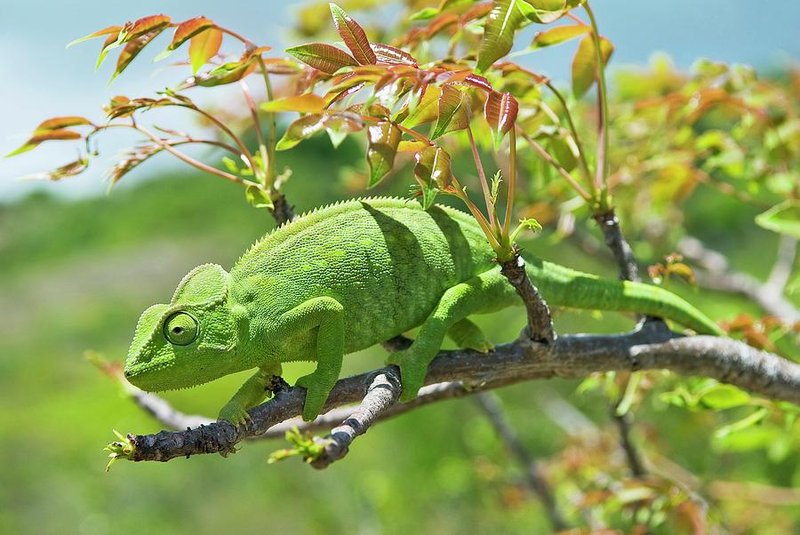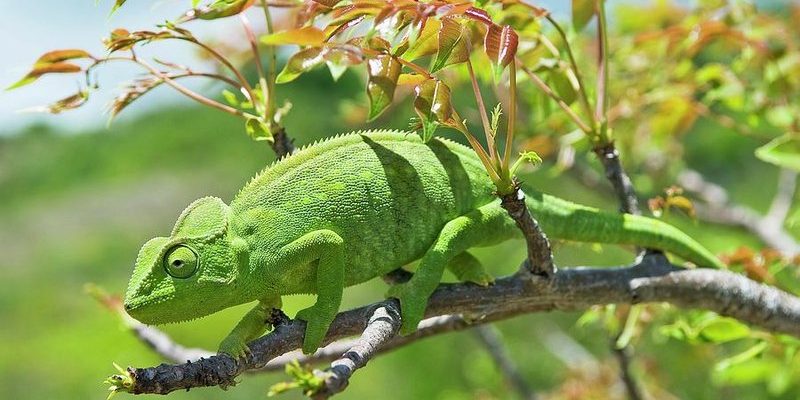
Choosing the best plants and décor is essential because these elements provide shelter, stimulation, and a way for your chameleon to exhibit natural behaviors. Imagine how a vibrant green backdrop can brighten your chameleon’s colors, making their world as lively as a sunny day. So, let’s dive into how you can craft an impressive and safe home for your flap-necked chameleon.
Understanding Flap-Necked Chameleons’ Needs
Flap-necked chameleons are fascinating creatures, known for their vibrant colors and unique personalities. To create a habitat that meets their needs, it’s crucial to understand their natural environment. In the wild, these chameleons thrive in tropical regions where they bask in the sun, climb through trees, and hide among foliage.
You might be wondering why the habitat’s layout matters so much. Well, just like us, chameleons need space to move, explore, and feel secure. A well-planned habitat can help reduce stress and promote healthy behaviors. Additionally, the right combination of plants and décor can enhance the aesthetics of their enclosure while providing the necessary elements for their well-being.
Selecting the Right Plants
When it comes to choosing plants for your flap-necked chameleon’s habitat, opt for ones that are both safe and appealing. Here are some top options:
- Pothos: This hardy plant is not only safe for chameleons but also grows quickly. Its trailing vines create a perfect climbing structure and cover.
- Ficus Benjamina: Also known as weeping fig, it offers a thick canopy for your chameleon to hide under. Make sure to keep it trimmed to prevent it from overshadowing your pet.
- Spider Plant: Easy to care for and safe, spider plants are great for adding greenery without the fuss. Plus, they look especially nice cascading down from higher spots in the habitat.
When introducing plants, ensure they are pesticide-free and thoroughly washed. You wouldn’t want your chameleon ingesting harmful chemicals. Plus, incorporating several plant species not only mimics their natural habitat but also provides various textures and hiding spots, which is essential for their comfort.
Arranging Your Habitat’s Layout
Now that you’ve chosen your plants, how do you arrange them? Think of it like designing a fun obstacle course. You want to create areas for climbing, hiding, and basking.
Start by placing taller plants toward the back or sides of the habitat. This creates layers, which helps your chameleon feel secure as they can perch high while observing their surroundings. Also, arrange plants at different angles to encourage climbing.
You could also provide a few flat surfaces or branches for basking. Ensure there’s ample open space for your chameleon to bask under a heat lamp. This combination of climbing opportunities and basking spots will give them a variety of experiences within their home.
Incorporating Décor Elements
Aside from plants, adding decorative features can enhance your chameleon’s habitat. Think of items that offer enrichment and contribute to the overall theme of a jungle oasis.
Consider adding:
- Branches or Driftwood: These provide natural climbing surfaces and help mimic their wild environment. Make sure they are untreated and free of chemicals.
- Hiding Spots: Small caves or hollow logs can serve as excellent retreats. Your chameleon will appreciate having a private space to relax and feel secure.
- Water Features: A small water bowl or a misting system can add humidity, which is crucial for your chameleon’s health. Think of it as a mini watering hole!
Placing these elements in various locations will encourage exploration and help your chameleon engage with its environment. Be mindful of the layout; you don’t want the décor to crowd the plants or limit your pet’s movement.
Maintaining Humidity and Temperature
One of the key aspects of a chameleon’s habitat is maintaining proper humidity and temperature. Flap-necked chameleons are native to humid environments, so their habitat should reflect that.
Here’s how to achieve this:
1. Misting: Regularly misting the plants and habitat will keep humidity levels where they need to be. Aim for around 50-70% humidity. You can use a manual sprayer or invest in an automatic misting system.
2. Temperature Regulation: Ensure you have a heat lamp to create a basking area. Ideally, your chameleon should have a basking spot around 85-95°F (29-35°C) and a cooler area that’s about 70-75°F (21-24°C).
3. Humidity Gauge: Installing a hygrometer will help you monitor humidity levels easily. Keeping an eye on this will ensure your habitat remains comfortable and suitable for your chameleon.
Maintaining these levels can seem daunting, but it’s crucial for their health and happiness. Regular checks will help you ensure everything stays just right.
Choosing the Right Substrate
The substrate, or bedding, you choose is another important aspect of your chameleon’s habitat. It should be safe and mimic their natural environment while also being easy to clean.
Consider these options:
- Paper Towels: This is the simplest choice for beginners. They’re easy to replace and keep things clean.
- Coconut Fiber: This natural option allows for good drainage and is a bit more aesthetically pleasing. However, ensure it’s changed regularly to avoid odors.
- Reptile Carpet: It’s reusable and easy to clean, but be cautious with the material to avoid any ingestion issues.
Choosing the right substrate will depend on your personal preferences and how much effort you’re willing to put into cleanliness. Just remember to avoid sand or loose substrates, as these can pose health risks to your chameleon.
Final Touches for A Cozy Home
After you’ve set up the plants, layout, décor, and other essentials, it’s time to step back and admire your work. But let’s keep it real; your chameleon won’t be as impressed as you are. Still, these final touches can make a difference in their day-to-day life.
Adding a few extra items, like:
1. Feeding Stations: Consider a dedicated spot for feeding, where you can place food securely without it rolling away or getting lost in the plants.
2. Climbing Accessories: Small, removable branches or vines can provide additional climbing options that you can change out from time to time for variety.
3. Interactive Elements: If your chameleon is comfortable with more human interaction, consider adding some gentle lighting or a small video monitor for observing behavior.
Creating a habitat is a bit of an art, and it can take some trial and error to find the right mix for your flap-necked chameleon. But with patience and a little creativity, you’re well on your way to providing an amazing home.
In summary, crafting the best habitat for a flap-necked chameleon involves a thoughtful balance of plants, décor, and environmental controls. By paying attention to these details, you’re not just creating a space; you’re transforming your chameleon’s life into a vibrant, interactive experience that reflects their natural habitat. Happy decorating!

